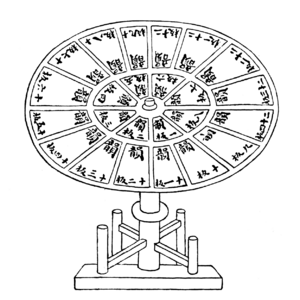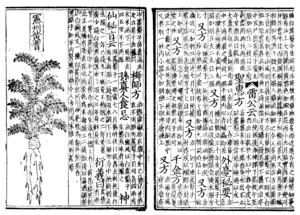Hua Sui facts for kids
Hua Sui (simplified Chinese: 华燧; traditional Chinese: 華燧; pinyin: Huá Suì; 1439–1513 AD) was a clever Chinese scholar, engineer, and printer. He lived in Wuxi, Jiangsu province, during the Ming dynasty (1368–1644 AD). Hua Sui came from a very rich and famous family. He is best known for inventing China's first metal movable type printing in 1490 AD. This was a big step forward in how books were made!
Contents
Metal Movable Type Printing: A Big Step Forward
Metal movable type printing was first invented in Korea in the 1200s. However, there is no clear proof that Hua Sui's invention was directly influenced by Korean printing. He likely developed it on his own.
Earlier Ways to Print: Wood and Ceramic Types
Movable type printing was actually invented in China many centuries before Hua Sui. A famous Chinese scientist named Shen Kuo (1031–1095) wrote about it. He said that an artisan named Bi Sheng (990–1051) first invented movable type using ceramic pieces around 1041–1048.
Later, during the Yuan dynasty (1279–1368 AD), a government official and scholar named Wang Zhen (around 1290–1333) improved wooden movable type. His method made printing much faster. Wang Zhen also tried using metal type made of tin. But he found that the tin type did not hold ink well. This made the printed books look messy, so it wasn't used for long.
This shows that early Chinese metal type printing using tin was not very successful. But Hua Sui's bronze metal type, invented later in the 1400s, worked much better. It was used in China for hundreds of years!
Metal Type Printing in the Ming Dynasty

Hua Sui didn't become a scholar until he was about 50 years old. He became very interested in printing books. He was wealthy and wanted to use his money to become a famous printer. In 1490, Hua Sui became the first in his family to use bronze-type printing.
The very first book printed with bronze type in China was called Zhu Chen Zou Yi. It was a collection of official reports. Hua Sui's books often had his special mark, Hui Tong Guan, which meant "Studio of Mastery and Comprehension." This showed he had mastered metal movable type printing. Over about 20 years, Hua Sui published 15 different books using his metal type.
Other members of Hua Sui's family also started using metal type printing. His distant relative, Hua Cheng (1438–1514 AD), had his own printing studio. He printed many rare books quickly using metal type. Hua Qian (around 1513–1516), Hua Sui's nephew, also became a bronze-type printer. His studio reprinted a huge old Tang dynasty encyclopedia. Overall, the Hua family helped publish about 24 books using metal type between 1490 and 1516.
Another important family in Wuxi, the An family, also started metal type printing. Their work came after the Hua family. The Hua family was likely inspired by Shen Kuo's writings about Bi Sheng's movable type. However, working with metal type was much harder than ceramic. It needed complex steps like engraving, casting, setting the type, inking, and printing.
Soon, bronze type books were also made in other cities like Changzhou, Suzhou, and Nanjing in the 1500s. Sometimes, more than one printer would share the cost of making different sizes of Chinese writing fonts. Besides bronze, other metals were used too. Some printers in the early 1500s used bronze and lead for their movable type.
Printing in the Qing Dynasty
During the Qing dynasty (1644–1911), the government mostly used wooden movable type for official printing. However, they also supported bronze-type printing. In 1725, they made 250,000 bronze characters to print a huge encyclopedia called Gujin Tushu Jicheng. This encyclopedia was 5020 volumes long! Sixty-six copies were made. Sadly, these bronze characters were later melted down in 1744 to make coins.
Outside the government, many smaller private printers also used metal type during the Qing period. For example, a printer named Lin Chun Qi spent 21 years (1825-1846) making about 400,000 bronze characters. These characters were used to print many different books, including those about medicine and military strategy.
How Metal Type Printing Worked

To create metal movable type characters, Chinese printers mostly used a method called casting. This was much easier than carving each character by hand, which would take a very long time, especially with metal. However, some records from the 1700s show that individual carving was also used.
When printing new books, ink was put on a plate, and paper was pressed onto it. This was similar to woodblock printing. Then, workers had to arrange and set the metal type characters. This process needed different people to do different jobs, like typesetting and printing. Some books from the Ming and Qing periods even listed the names of the workers who helped print, publish, and sell them.
It can be hard to tell if an old book was printed using movable type or woodblocks. But there are clues! Books made with movable type often have small mistakes. You might see characters that are not perfectly lined up or have uneven spaces. However, as printers like Hua Jian and An Guo got better, their movable type books became almost as perfect as woodblock prints.
See also
- List of Chinese inventions
- History of typography in East Asia.
- Technology of the Song dynasty




